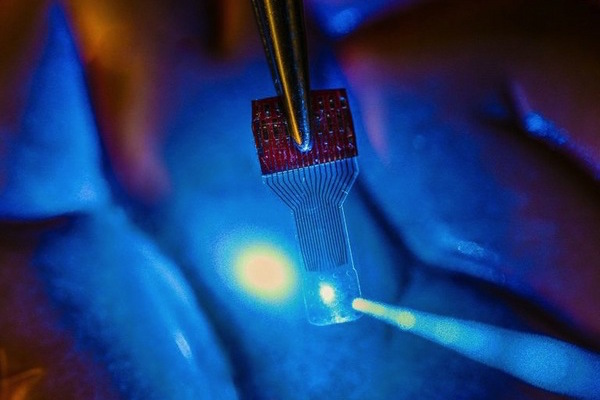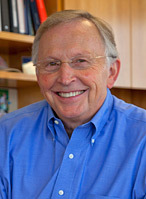Wisconsin Alumni Research Foundation near the top of the patent charts for 2013

A blue light shines through a clear implantable medical sensor onto a brain model. This technology to improve the control of prosthetic devices by the brain was developed by UW–Madison engineers.
Photo: Justin Williams research group
In 2013, with 160 patents, the Wisconsin Alumni Research Foundation (WARF) was near the pinnacle of the university patent heap.
WARF, the private, not-for-profit foundation that manages the bulk of the University of Wisconsin–Madison’s intellectual property portfolio, was sixth among the world’s universities in patents obtained for new technologies, according to a survey conducted by the National Academy of Inventors (NAI) and the Intellectual Property Owners Association (IPO). WARF and UW–Madison rank behind only the University of California System, MIT, China’s Tsinghua University, Stanford University and the University of Texas.

Carl Gulbrandsen
“The ranking reflects the quality of our faculty, staff and student inventors and the commitment we’ve made over many years to capture great ideas and put them to work for society,” says Carl Gulbrandsen, WARF’s managing director. “It shows that the university and WARF are doing their part to provide a tangible return on the investment Wisconsin makes in higher education and research.”
The ranking includes 100 universities worldwide. Data was gathered from the U.S. Patent and Trademark Office and reflects patents awarded during the 2013 calendar year.
Some of the Wisconsin technologies reflected in the ranking include:
- A prostate cancer vaccine, licensed to Madison-based startup company Madison Vaccines Inc.
- A method for modifying lignin, the natural polymer in plants that makes them rigid and woody but hinders their use for things like paper pulp and biofuel.
- A clean compression engine combustion process to improve efficiency and reduce emissions.
- A method for efficiently removing lipids from whey, a byproduct of cheesemaking.
- Technology to improve the control of prosthetic devices by the brain.
“These innovations can help solidify the transfer of cutting-edge research to the marketplace, producing revenue and expanding the economy,” according to IPO Executive Director Herbert C. Wamsley.
Established in 1925, WARF is one of the world’s oldest university intellectual property organizations. A portion of the licensing revenue is shared with the inventor, with the remainder invested in the WARF endowment, which helps support the UW–Madison research enterprise in the form of an annual grant. In 2014, WARF returned more than $73 million to UW–Madison and the Morgridge Institute for Research. That support was used to provide seed funding and continuing support for research.




